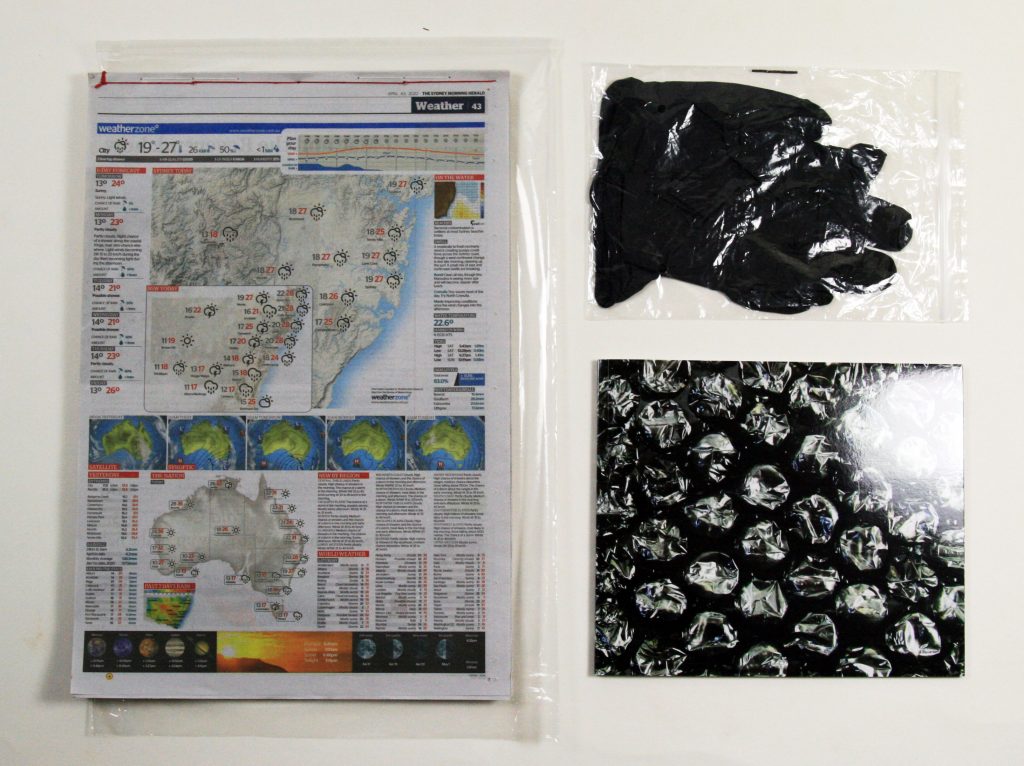The amount of plastic being produced today is enormous. ENORMOUS doesn’t come anywhere close to describing the impact this petroleum based product, in all its iterations, is having on the planet. The three works in this project look to the future imaging a world where plastic is no longer produced — how archeologists will look back at our era and see in the strata of human existence a suffocating layer of plastic.
The works are presented and boxed as through they were archeological items in a museum where the detritus of today is treated as precious objects in the future.
Each work is a unique work.

BOOKS
Book of Rain
2019 – 2020
Until the end of May 2020 the daily newspaper was delivered by the local newsagent. If it was raining or rain was forecast, he would wrap it in plastic. The sheets of plastic wrapping film, having a greenish tinge, when stacked looked uncannily like water. This is how the Book of Rain came about.
The book chronicles rainy days, yet is without specified location or time period. It represents any rainy season, any year, anywhere. With the work, as auxiliary support documentation, is a pad binding of two months (April-May 2020) of the weather page from the Sydney Morning Herald, the paper delivered. This pad of weekly weather forecasts offers context but only symbolically.
With pages made from the discarded plastic film and bound using other found plastic scraps and string, plastic debris that has ‘washed’ into the house, the book has the word ‘fragile’ (printed on orange packing tape) stuck to black plastic wrapped around the spine of the book. The irony is the tape, the plastic, the book is anything but fragile. The red and white strapping tape contains the bulging fore edge of the book.
As this is an archeological relic of the future, gloves for handling the work are also included.


Dead Sea Scroll—the legacy of plastic
2019–2020
This scroll is referencing the Dead Sea scrolls found in caves on the upper northwest shore of the Dead Sea (1947–1956) and estimated to have been created 2000 years ago. However this work doesn’t reach back into the past but forward into the future. The amount of plastic swilling in the oceans is constantly increasing at a frightening rate. In the plastic saturated water life fades away. Our blindness to the “inconvenience” of the dead sea future is blinded by the daily convenience of plastic, so much of it single use, yet extremely long lasting. No one is taking responsibility for this future.
The constant inflow of plastic in the house is unstoppable. Even with a commitment to reduce plastic consumption it arrives daily. How to stop it ending up in landfill or in the oceans is to not throw it out. How quickly it builds up. The scroll, a wrapping of this rubbish, is now an object travelling into the future. It will be a record of this time. Like the Dead Sea scrolls, to open it would be to destroy it and like the Dead Sea scrolls which could be read only via x-ray so there is a x-ray record of this scroll.
As this is an archeological relic of the future, gloves for handling the work are also included.


Plastic Tabloid
2021
WOULD YOU LIKE PLASTIC WITH THAT?
IS IT PLASTIC AS USUAL?
MUST IT BE PLASTIC OR NOTHING?
IS THIS PART OF A PLAN?
When the new newspaper delivery service took over they wrapped the paper in plastic film every day unlike the local newsagent who had wrapped it only on rainy days. I collected it without knowing what I would do with it— always aware of our societal inability to face the long term consequence of this convenient product, plastic, which I notice broken, dirty, discarded littering the unattended zones of the public space everywhere.
In her book Love for Sale: The Words and Pictures of Barbara Kruger, Kruger turned the seductive croon of advertising into shouts of cold hard truth telling, exposing the manipulation by companies wanting to sell us products by promulgating a myth of happiness and security through consumption. Somehow we are now trapped in the myth of plastic convenience at any cost.
Using second hand wooden type to print the text onto the plastic “pages” history time-warped. I realised the beginning of our modern era was marked by the Gutenberg’s invention of moveable type, like the type I was using. The age of print: moveable type, the 4 colour print process CMYK and the once ubiquitous newspaper now stumbling towards oblivion? Would you like plastic with that?

